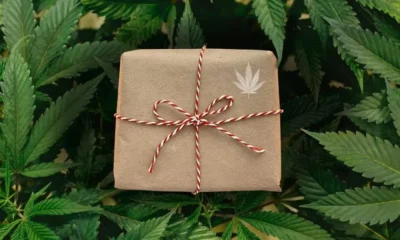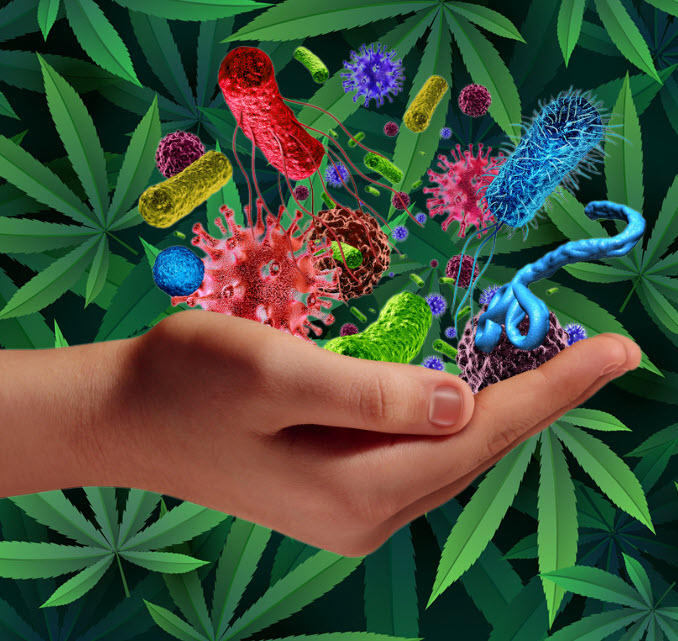Cannabis News
The Medical Benefits on the Human Body When You are High on Cannabis
Published
3 months agoon
By
admin

The Medical Benefit of the Altered State
While browsing Reddit during my cannabis research, I stumbled upon a thought-provoking post by a user we’ll call “Anonymous.” Their stance was clear: marijuana will soon be viewed as negatively as tobacco, complete with cancer warnings and a decline in its perceived medical benefits. Anonymous argued that the push for medical marijuana is either naive or driven by profit-seeking companies, drawing parallels to past tobacco industry tactics.
This article aims to delve deep into the heart of this debate, exploring how cannabis actually interacts with our bodies and why it seems to offer such a wide range of healing properties. We’ll journey through the fascinating world of the endocannabinoid system – a complex network that plays a crucial role in maintaining our body’s balance.
As we unpack the science behind cannabis, we’ll challenge the notion that its medical potential is merely a “fake medicinal thing.” Instead, we’ll explore how this plant’s compounds work in harmony with our own biological systems, potentially offering relief for various conditions.
But here’s where things get really interesting: what if the very “high” that some criticize is actually key to some of cannabis’ therapeutic effects? What if that altered state isn’t just about recreation, but about rewiring the brain and body for healing?
Buckle up, because we’re about to dive into a world where molecules dance with receptors, where ancient plant wisdom meets cutting-edge science, and where the line between medicine and nature blurs in the most intriguing ways.
To understand the profound impact of cannabis on human health, we must first explore the endocannabinoid system (ECS) – a complex network of receptors and molecules spread throughout our bodies. This system plays a crucial role in maintaining homeostasis, essentially acting as a master regulator for numerous bodily functions.
The ECS helps regulate:
-
Mood and stress response
-
Sleep patterns
-
Appetite and metabolism
-
Pain sensation
-
Memory and learning
-
Immune system function
-
Inflammation
-
Cardiovascular function
-
Reproductive system
-
Bone growth and density
-
Neuroprotection
-
Digestive processes
This extensive list demonstrates why cannabis seems to affect so many aspects of our health and well-being. But to fully grasp its impact, we need to understand how the ECS develops and changes throughout our lives.
During our formative years, up until about age 25, our bodies produce an abundance of endocannabinoids – the natural compounds that interact with the ECS. This overproduction serves a vital purpose: it’s building and fine-tuning the endocannabinoid system. This is precisely why many experts recommend avoiding cannabis consumption during these crucial developmental years. Introducing external cannabinoids could potentially interfere with this delicate process.
Those who experimented with cannabis in their teens might recall experiencing incredibly intense highs. This heightened sensitivity is directly related to the abundance of endocannabinoids and receptors during this period. As we mature, the experience often changes. The highs may feel different or less intense, not just due to tolerance, but because our endocannabinoid system has fully developed and our natural production has decreased significantly.
Here’s where things get interesting: as we age, especially when faced with chronic stress, injuries, or other health challenges, our endocannabinoid system can become depleted. This depletion may contribute to various health issues, as the body struggles to maintain balance without its full regulatory arsenal.
This phenomenon helps explain why many older adults, particularly those trying cannabis for the first time in their 60s or beyond, report such remarkable benefits. By introducing phytocannabinoids (plant-derived cannabinoids) into their systems, they’re essentially revitalizing a depleted endocannabinoid system, kickstarting its regulatory functions back into high gear.
The key to understanding this lies in the remarkable similarity between phytocannabinoids (like THC and CBD) and our body’s own endocannabinoids. These plant-derived compounds fit almost perfectly into our endocannabinoid receptors, allowing them to mimic and supplement the work of our natural endocannabinoids.
Think of consuming cannabis as akin to taking a multivitamin supplement. Just as vitamins can help fill nutritional gaps and support overall health, phytocannabinoids can help replenish and support a potentially undernourished endocannabinoid system. This supplementation may help bring various bodily systems back into balance, potentially explaining the wide range of reported health benefits.
With this foundation, we can begin to appreciate the potential medical applications of cannabis. The plant’s ability to interact so seamlessly with our endocannabinoid system offers a scientific basis for its reported effects on pain, inflammation, mood, and numerous other health concerns.
However, a crucial question remains: what about the psychoactive effects, the infamous “high” associated with cannabis use? Is it merely a side effect, or could it play a more significant role in the plant’s therapeutic potential?
As we delve deeper into the world of cannabis and its effects on the human body and mind, we’ll explore a fascinating possibility: what if the altered state of consciousness induced by cannabis is not just a recreational byproduct, but a key component of its healing power? Could the very experience that some view as problematic be an essential part of cannabis’ ability to treat certain conditions?
Keep on reading as we unravel this intriguing aspect of cannabis therapy, challenging preconceptions and exploring the complex interplay between mind, body, and this ancient medicinal plant.
Now that we’ve established a foundational understanding of how cannabis interacts with our endocannabinoid system, let’s delve into a more controversial aspect: the potential medical benefits of the cannabis-induced “high.”
Given that the endocannabinoid system plays a crucial role in neuroprotection, it’s reasonable to hypothesize that the altered state of consciousness produced by cannabis serves a purpose beyond mere recreation. In fact, this euphoric state might be a key component of cannabis’ therapeutic potential.
When a person consumes cannabis and experiences a “high,” their brain enters a state of enhanced neuroplasticity. Neuroplasticity refers to the brain’s ability to reorganize itself by forming new neural connections. In this state, neurons become more “agile,” allowing for potential rewiring of established neural pathways.
This increased neuroplasticity can be particularly beneficial for individuals suffering from conditions like PTSD. People with PTSD often have deeply ingrained neural networks associated with their trauma. The heightened neuroplasticity induced by cannabis can help them view their experiences from a different perspective, potentially breaking out of the “neuro prison” of their condition. It offers an opportunity to interrupt and reshape the negative feedback loops that perpetuate their trauma responses. While this process can be helpful on its own, it becomes even more effective when combined with proper therapy and guidance.
The benefits of this cannabis-induced neuroplasticity extend beyond PTSD. It may also prove helpful in treating other psychological conditions such as depression, anxiety disorders, and eating disorders. By allowing the brain to form new connections and patterns, cannabis could help individuals break free from rigid thought patterns and behaviors associated with these conditions.
Moreover, the pleasurable nature of the cannabis high for many users serves another important physiological function. This positive experience can shift the nervous system from sympathetic dominance (the “fight, flight, freeze, or fold” state) to parasympathetic dominance (the “rest, digest, heal, and recover” state). This shift is crucial for healing, as the body performs most of its repair and regeneration processes in the parasympathetic state.
Given these factors, we can conclude that the euphoric state induced by cannabis does indeed have potential medical benefits. The combination of increased neuroplasticity and nervous system relaxation creates an environment conducive to healing and personal growth.
However, it’s crucial to emphasize that this “phyto-euphoria” should not become a crutch or the primary mode of operation for individuals dealing with psychological issues. While cannabis can be a powerful tool, it should be used consciously and in conjunction with other therapeutic approaches. The most effective path to healing often involves directly addressing the root causes of psychological distress, which may require professional help and personal introspection.
Cannabis, when used mindfully, can assist in this process. It can help create mental space for new perspectives and facilitate a physiological state that supports healing. But the key word here is “consciously.” Users should approach cannabis with intention, using it as a tool for growth and healing rather than mere escape or avoidance.
Within this context, we can see that the “medical high” is a reasonable position to take. Of course, more research will uncover any grey areas within this proposition, however, I encourage you all to do your own research on the matter to verify for yourself.
Contrary to “Anonymous'” prediction, I don’t foresee cannabis following the same path as tobacco. While both plants have faced scrutiny and regulation, their trajectories differ significantly due to their vastly different effects on human health and their potential therapeutic applications.
I believe cannabis is on a path to becoming as commonplace as corn. However, the road to this normalization is far from straightforward. I’ve learned to avoid making timeline predictions, as the pharmaceutical industry and anti-cannabis lobbyists wield considerable influence, often swaying politicians with the ease of trading football players.
Nevertheless, we’ve reached a point of no return. The proverbial genie is out of the bottle, and the cat is out of the bag. For over 70 years, cannabis was demonized based on flawed science and misinformation. Today, as rigorous research continues to unveil the plant’s potential benefits and its intricate dance with our endocannabinoid system, the scientific tide is turning in favor of cannabis.
If you quiet your mind and tune into the zeitgeist, you can almost hear the faint death rattle of prohibition. The current challenges to cannabis reform are merely the last gasps of a dying era – the rigor mortis of outdated policies and perspectives. Soon, this opposition will flatline entirely, paving the way for a new era of understanding and acceptance.
As we move forward, it’s crucial to approach cannabis with respect, knowledge, and intention. By doing so, we can harness its potential benefits while mitigating risks, ultimately integrating this ancient plant medicine into our modern healthcare and wellness practices.
MEDICAL BENEFITS OF WEED, READ ON…
You may like
-


California Appeals Court Rejects Marijuana Grow Permit, Citing Federal Illegality
-


Expert Lighting Tips For Successful Indoor Growing Weed
-


Acne And CBD: Exploring Alternative Dermatological Solutions
-


Can I Gift Marijuana This Holiday Season?
-


The Best Cocktails For An Easy Festive Thanksgiving
-


420 Vacations: Planning the Perfect Weed Vacation
Cannabis News
California Appeals Court Rejects Marijuana Grow Permit, Citing Federal Illegality
Published
40 minutes agoon
November 22, 2024By
admin
In a landmark decision that highlights the tension between state and federal cannabis laws, a California appellate court ruled on October 29th that property owners can refuse to allow the transportation of cannabis across their land via easements, even when the cannabis operation is approved by local authorities.
The Second District Court of Appeal’s unanimous decision draws attention to private property rights in a context where cannabis remains federally illegal, but state law allows licensed cultivation, distribution and sale. Presiding Justice Albert Gilbert stated, “No matter how much California voters and the Legislature might try, cannabis cultivation and transportation are illegal in California as long as it remains illegal under federal law.” JCCrandall LLC v. County of Santa Barbara, Case No. B333201, 2024 WL 4599304, Oct. 29, 2024.
Unless the California Supreme Court grants review – which I would not rule out – the decision empowers private property owners to refuse to contract with cannabis businesses, and restricts local government from approving cannabis operations that implicate the property rights of neighbors who object.
The case at hand
The dispute centered around a cannabis cultivation operation in Santa Barbara County, where JCCrandall LLC challenged a conditional use permit granted by the County to its neighbor, Santa Rita Holdings Inc. The critical issue was that Santa Rita Holdings could only access its 2.5-acre cannabis farm via an unpaved road crossing JCCrandall’s property through a pre-existing easement. JCCrandall grows oats and barley.
JCCrandall’s primary concern? It raised a number of complaints with the Santa Barbara County Supervisors about truck traffic and night operations, which did not gain traction, but in the Court of Appeal JCCrandall focused on what it claimed was potential liability associated with having federally illegal substances transported across its property, even though County regulators found that the Santa Rita operation was fully compliant with state and local laws.
Key legal findings
The appellate court’s decision hinged on several crucial points:
- Property Rights: The court emphasized that “the right to exclude others is the essence of the right of property ownership” and classified it as a fundamental vested right.
- Federal Supremacy: The panel determined that allowing cannabis transportation across private property “defies the Supremacy Clause” of the U.S. Constitution.
- State vs. Federal Law: While cannabis might be legal under California law, the court ruled that federal law’s prohibition takes precedence in this context.
California cannabis industry implications
Legal experts suggest this ruling could have far-reaching consequences for California’s cannabis industry. Section 1550.5(b) of the California Civil Code makes contracts within California involving cannabis lawful and enforceable, and Santa Rita Holdings bet the ranch on that argument. But the Court of Appeal held that the statute could not compel a landowner to allow cannabis to travel across its property on a pre-existing easement. Licensed operators may find it harder to do business because neighbors who have property rights affected by a cannabis business can object, and, under the JCCrandall ruling, local government must yield to those objections.
An example might be a cannabis dispensary that depends on access to its parking lot via an easement or is located in a shopping center where other lessees have rights to object to tenants notwithstanding the approval of the landlord. In cultivation, many cannabis farms depend on vehicular access through easements because they are remote and do not always have direct access to public thoroughfares, or they depend on water sourced from other properties pursuant to agreements made by prior owners who grew traditional crops. These neighbors might not need to show any negative impact on their property, but can argue that they could be found complicit in federally illegal activities.
I think the most problematic language in the JCCrandall ruling is the following, which might draw the attention of the California Supreme Court and cause it to grant review: “For as long as an easement is enjoyed, its mode and manner of use shall remain substantially the same as it was at the time the easement was created. The County argues the easement was used for agricultural purposes. But there is a vast difference between legal and illegal agricultural purposes.” (Emphasis added.) If California has determined that cannabis cultivation is legal – as it has – and state courts routinely enforce contracts involving cannabis, it is a pretty bold step to declare the use of a lawful pre-existing easement illegal simply because the agricultural crop is cannabis and take away easement access from Santa Rita.
Looking ahead
This decision creates new challenges for cannabis businesses in California, and will result in more disputes among neighbors. While the Biden administration has shown signs of easing federal marijuana restrictions, this ruling demonstrates that the federal-state law conflict continues to create significant legal hurdles for the cannabis industry.
California court decisions also can be persuasive authority in other states, so we might see similar litigation (and decisions) elsewhere in the country where cannabis has been legalized.
The case serves as a reminder that despite California’s progressive stance on cannabis, federal prohibition continues to cast a long shadow over the industry’s operations and development. As the cannabis landscape continues to evolve, this ruling may prompt businesses to reassess their property arrangements and local governments will certainly have to reconsider their permitting processes to give more careful consideration to objections by neighbors who claim that their property rights are implicated by cannabis operations.
Note: This post was first published earlier this month on the Alger ADR Blog.
Cannabis News
Autoimmune Conditions Are Rising Fast in American Medicine, Can Cannabis Help?
Published
1 day agoon
November 21, 2024By
admin

Why Are Autoimmune Conditions On The Rise? And How Cannabis Can Help
Autoimmune diseases refer to a group of medical conditions that occur as a result of the immune system attacking your own tissues.
In a normal human body, the immune system is responsible for protecting the body by producing antibodies that prevent toxins, cancer cells, and viruses from harming the body. However, when one is struck by an autoimmune disorder, the immune system is no longer able to distinguish the difference between dangerous cells and healthy cells. As a result, the healthy cells are attacked, too.
Today, we know of around 100 different kinds of autoimmune conditions. Some of the most common examples of autoimmune conditions include rheumatoid arthritis (RA), lupus, inflammatory bowel disease, celiac disease, Type 1 diabetes, multiple sclerosis (MS), and the Guillain-Barre syndrome (GBS) to name a few. Others include Graves’ disease, Hashimoto’s thyroiditis, psoriasis, and vasculitis.
According to the National Health Council, around 50 million Americans are affected by autoimmune diseases today. This is a conservative estimate, considering that several autoimmune conditions are tricky to treat and so many people go undiagnosed for long periods of time. It’s worrisome to note that there are more people developing autoimmune diseases these days, many of which have reached levels comparable to epidemics.
But cannabis can help!
How Cannabis Can Help Curb And Manage Autoimmune Diseases
Not one single cause is responsible for the alarming growth of autoimmune diseases, though there are several factors at play. While there isn’t just one cause we can point at, it’s certain the reasons lie in our environment. After all, human genetics haven’t changed significantly yet the chemicals, toxins, and pollutants in our food and everyday items have risen dramatically.
In addition, people are getting less sleep than ever; stress rates are through the roof, and people are constantly worried. There is a clear link between psychological stress and physical health as well as immunity, which is why it isn’t unusual – it’s even common – to see many autoimmune disease cases flare up after people experience severe stress caused by grief, an accident, job loss, or the death of a loved one. These highly stressful and traumatic conditions wreak havoc on the body’s immune response, causing inflammation all over the body.
Conventional treatments prescribed to treat autoimmune conditions are focused on taming inflammation; these usually include steroids but also some non-steroidal drugs. These drugs often come with unwanted side effects, but research has shown that cannabis can work with the endocannabinoid system through THC and CBD, as well as other cannabinoids, to simulate similar results. In one study for example, we can see the clear association of the endocannabinoid system for neurodegenerative and inflammatory processes seen in Multiple Sclerosis and Amyotrophic Lateral Sclerosis.
There has also been an increasing number of studies proving the efficacy of cannabis for treating several autoimmune conditions.
Cannabis For Multiple Sclerosis
Multiple sclerosis is one of the autoimmune conditions where a growing number of studies have come out supporting the therapeutic benefits of cannabis for. In a 2024 study, patients with multiple sclerosis reported several improvements in quality of life after using cannabis-based medical products (CBMPs). For the study, British investigators analyzed the impact of cannabis based medicinal products made from either oil or extracts in 141 patients who were enrolled in the UK Medical Cannabis Registry.
The researchers then analyzed the changes in patient outcomes after a month, then three and 6 months after. According to the patients themselves, they were able to sustain improvements in their mental and physical health after marijuana therapy.
“This case series demonstrates a potential association between the initiation of CBMPs and improved patient reported outcomes in sleep, anxiety, and general HRQoL [health-related quality of life] measures, over six months,” said the study authors. “Additional measures for HRQoL, including various physical and mental health subdomains, also exhibit improvements up to six months when compared to baseline,” the authors concluded.
In another study from 2023, patients with multiple sclerosis reported significant improvements in symptoms after cannabis use. For the study, researchers from the Dent Neurologic Institute in Buffalo, New York, analyzed the medical records of 141 patients with multiple sclerosis, who were also legally authorized to consume medical marijuana products. They then analyzed data from the patients after one up to 4 follow-up sessions after the initial session of cannabis therapy. Sixty-five percent of patients consumed 1:1 THC:CBD tinctures.
According to the authors: “The results of this study indicate that use of MC [medical cannabis] to alleviate symptoms of MS is largely efficacious, with improvement in pain (72 percent of patients), muscle spasticity (48 percent of patients), and sleep disturbance (40 percent of patients) frequently reported.”
“More than half of opioid users at baseline were able to either discontinue or decrease their opioid use after starting MC. The mean daily MME [morphine milligram equivalents] was significantly reduced from the initial visit (51 mg) to the last follow-up visit (40 mg). This is consistent with previous literature showing that MC legalization is associated with decreased opioid use and that MC use is associated with decreased opioid use in patients with chronic pain. These findings indicate that MC may represent an alternative analgesic to opioids for some patients,” they wrote.
Anecdotal Evidence
While more studies are needed to determine cannabis’ effect on other autoimmune conditions such as rheumatoid arthritis, we can rely on anecdotal evidence. In 2020, data from the medical journal, Rheumatology, revealed that patients who have this condition, along with those who have lupus and fibromyalgia, consume cannabis.
In fact, it was reported that marijuana was extremely common especially for patients with fibromyalgia. “In this meta-analysis, we found that one in six patients suffering from rheumatologic disease actively consumes cannabis, reducing pain reduction… A favorable effect of cannabis on pain in our meta-analysis reinforces the idea that cannabis could be used for analgesic purposes,” the authors concluded.
Conclusion
Cannabis is a safe and natural way to help prevent and treat the symptoms of autoimmune disease. It targets inflammation at its root, and is a proven natural way to help cope with stress, pain, insomnia, and inflammation all while protecting the brain. However, it’s important to ensure you medicate with clean, organic sources of marijuana.
AUTOIMMUNE AND CANNABIS, READ ON…

The U.S. Senate’s version of the Farm Bill finally landed this week. They’re calling it the Rural Prosperity and Food Security Act of 2024 (the “Senate bill”). The Senate bill follows on the House’s proposal, called the Farm, Food and National Security Act of 2024 (the “House bill”), offered in May. Neither the Senate bill nor the House bill would preempt state or Indian law regarding hemp or the regulation of hemp products. This means states and tribes will retain a lot of latitude in regulating hemp and hemp-derived products– which gets people fired up.
Aside from giving states some runway, the Senate bill and the House bill differ in key respects regarding hemp. Therefore, these august bodies must confer and reconcile their sundry proposals. That could happen in 2024, but seems more likely in 2025 when the new Congress convenes. As of this week, though, we finally have a framework.
The Senate Bill re-defines “hemp” and defines “industrial hemp”
Section 10016 of the Senate bill (“Hemp Production”) amends the definition of “hemp.” Hemp was defined in the 2018 Farm Bill and removed from the federal Controlled Substances Act (CSA), taking us on a truly wild ride. See: What Happened to Hemp? (“What Happened”). The Senate bill also gives us a definition for “industrial hemp.” Here are those definitions, with points of emphasis in bold:
(1) Hemp. The term “hemp” means (A) the plant Cannabis sativa L. and any part of that plant, including the seeds thereof and all derivatives, extracts, cannabinoids, isomers, acids, salts, and salts of isomers, whether growing or not, with a delta-9 total tetrahydrocannabinol concentration (including tetrahydrocannabinolic acid) of not more than 0.3 percent on a dry weight basis; and (B) industrial hemp.
(3) Industrial Hemp. The term “industrial hemp” means the plant Cannabis sativa L. if the harvested material (A) is only (i) the stalks of that plant, fiber produced from those stalks, or any other manufactured product, derivative, mixture, or preparation of those stalks (except cannabinoid resin extracted from those stalks); (ii) whole grain, oil, cake, nut, hull, or any other compound, manufactured product, derivative, mixture, or preparation of the seeds of that plant (except cannabinoid resin extracted from the seeds of that plant); or (iii) viable seeds of that plant produced solely for production or manufacture of any material described in clause (i) or (ii); and (B) will not be used in the manufacturing or synthesis of natural or synthetic cannabinoid products.
The new regime
Again, the definitional stuff in bold is what I want to emphasize.
First, the Senate bill keeps the THC threshold at 0.3 percent, which is an arbitrary number we’ve been advocating against for years. The Senate bill mirrors the House bill in this respect, though, so we are stuck with this, unless Ron Paul gets his way.
Second, the Senate bill keeps the 2018 Farm Bill’s total THC standard, including THCA. The House bill does this too. This was fairly predictable: in What Happened, I wrote that we could “expect the total THC standard to remain, which means that actual Delta-9 THC won’t be the only metric for calculating THC content.”
We’ve also explained on this blog that the 2018 Farm Bill and USDA rules mandate total THC testing on pre-harvest hemp batches, but do not mandate such testing on post-harvest hemp or hemp products. The Senate bill doesn’t change this paradigm, which means the “loophole” for gas station weed remains open. This proposal is a big win for opponents of the House bill’s “Miller Amendment,” which would narrow the definition of “hemp” to exclude intoxicating hemp-derived substances.
Third, the Senate bill introduces a new definition and framework for industrial hemp. The House bill does this too, albeit slightly differently. The idea here is to invite farmers to grow hemp for fiber and grain purposes, while freeing them from regulatory burdens with the Department of Agriculture and criminal exposure with the Department of Justice. More specifically, for “industrial hemp” growers, the Senate bill:
- removes background check requirements;
- instates “relaxed regulatory requirements” for sampling and inspection methodologies (which will need to be adopted by rule); and
- develops a certified seed program.
The Senate bill also makes any hemp producer ineligible to grow hemp for five years if that producer, “with a culpable mental state greater than negligence, produces a crop of hemp that is inconsistent with that license.”(Hint: use the seed program.) The proof standard here seems like it could be an issue, and even if anyone has been adjudicated as growing marijuana under the guise of hemp, Farm Bill ineligibility seems like a far-off concern.
Bottom line
The big takeaway for me is that the Senate bill leaves the door open for intoxicating hemp products, whereas the Miller Amendment to the House bill does not. Something’s gotta give. And it needs to happen soon, because we’re already long overdue. As I explained in a webinar last week, the Farm Bill deals with the nation’s entire food supply, not just hemp. Therefore, this is not like with the SAFE Banking Act, where we have a proposed law specific to cannabis that may or may not ever pass. The Farm Bill must pass, and soon.
Stay tuned and we’ll keep you updated on any major happenings. For more on this topic, check out our massive hemp and CBD archive, or these specific, recent posts:

California Appeals Court Rejects Marijuana Grow Permit, Citing Federal Illegality

Expert Lighting Tips For Successful Indoor Growing Weed

Acne And CBD: Exploring Alternative Dermatological Solutions

Can I Gift Marijuana This Holiday Season?

The Best Cocktails For An Easy Festive Thanksgiving

420 Vacations: Planning the Perfect Weed Vacation

Can Microdosing Help Manage Holiday Family Anxiety

11 Weed Shows and Movies on Netflix Worth Watching

Lawsuit Says DEA Acting In Bad Faith Over Marijuana

Autoimmune Conditions Are Rising Fast in American Medicine, Can Cannabis Help?

Distressed Cannabis Business Takeaways – Canna Law Blog™

United States: Alex Malyshev And Melinda Fellner Discuss The Intersection Of Tax And Cannabis In New Video Series – Part VI: Licensing (Video)

What you Need to Know

Drug Testing for Marijuana – The Joint Blog

NCIA Write About Their Equity Scholarship Program

It has been a wild news week – here’s how CBD and weed can help you relax

Cannabis, alcohol firm SNDL loses CA$372.4 million in 2022

A new April 20 cannabis contest includes a $40,000 purse

Your Go-To Source for Cannabis Logos and Designs

UArizona launches online cannabis compliance online course
Trending
-

 Cannabis News2 years ago
Cannabis News2 years agoDistressed Cannabis Business Takeaways – Canna Law Blog™
-

 One-Hit Wonders2 years ago
One-Hit Wonders2 years agoUnited States: Alex Malyshev And Melinda Fellner Discuss The Intersection Of Tax And Cannabis In New Video Series – Part VI: Licensing (Video)
-

 Cannabis 1012 years ago
Cannabis 1012 years agoWhat you Need to Know
-

 drug testing11 months ago
drug testing11 months agoDrug Testing for Marijuana – The Joint Blog
-

 Education2 years ago
Education2 years agoNCIA Write About Their Equity Scholarship Program
-

 Cannabis2 years ago
Cannabis2 years agoIt has been a wild news week – here’s how CBD and weed can help you relax
-

 Marijuana Business Daily2 years ago
Marijuana Business Daily2 years agoCannabis, alcohol firm SNDL loses CA$372.4 million in 2022
-

 California2 years ago
California2 years agoA new April 20 cannabis contest includes a $40,000 purse





